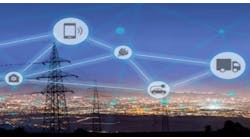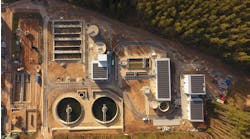Q&A: Evolution of the microgrid and the growth of digital energy
A few weeks back we shared the news about Schneider Electric's ranking atop Guidehouse Insights' Microgrid Integrator Leaderboard.
We wanted to dive a little deeper, so we connected with experts from Schneider Electric's energy division to explore the evolution of the microgrid and the concept of digital energy. Take a look...
Smart Industry: Describe the modern microgrid.
Bala Vinayagam, senior vice president, microgrid business, Schneider Electric: Modern microgrids are systems that are intelligent and provide decentralized flexibility to the greater grid by meeting needs of future energy prosumers. Modern microgrids deliver the ability to scale and provide solutions for resilience, sustainability and energy savings for both large, complex enterprises and standardized systems for repeatable, smaller-to-medium enterprises. The ability to work alongside the grid and deliver capabilities that enhance the use of on-site renewables with energy storage can also deliver benefits beyond the site’s needs back to the grid. This element of grid-interactivity maximizes the sustainable and financial impacts of the microgrid and also requires a coordination and interaction between the larger energy grids and buildings.
Smart Industry: How is this approach to energy different than how we've historically used / stored energy?
Manish Kumar, executive vice president, global digital-energy division, Schneider Electric: Climate change and energy crisis cause building owners to use energy more efficiently and to transition from fossil fuels to renewables. The energy landscape is shifting from uni-directional, where energy flows one way from the grid to homes and buildings, to bi-directional in which energy flows between home and buildings and the grid. This energy flow is changing due to empowered energy consumers known as prosumers, who consume, manage, and produce their own energy.
We are accelerating the new energy landscape by enabling commercial and industrial customers to become prosumers. This is achieved through electrification and digital solutions that can interact with the grid, resulting in resilience, decarbonization, and energy independence.
The core technologies that provide prosumers with the capabilities to produce, consume and control their energy, include microgrids, EV charging and fleet solutions, and battery storage. Together, these technologies can deliver essential capabilities that benefit commercial and industrial customers by providing energy independence, flexibility, and the ability to monetize energy, ultimately creating a regenerative building.
Microgrids provide a cornerstone solution for prosumers, delivering resilience, sustainability, and energy optimization for commercial and industrial customers. In addition, battery energy-storage systems offer commercial and industrial customers a flexible and resilient solution for maintaining consistent power, regardless of any fluctuations or outages that may occur and contribute to overall impact to prosumers.
Smart Industry: How is the use / application / diversity of locations with microgrids changing?
Bala: Microgrid adoption is growing to include a more diverse landscape of needs and use cases. Therefore, more advanced technology, systems, standardization and modularity of microgrid systems can deliver the needs of unique use cases. The needs and challenges by region are unique as well. In North America, the need for more resilience influenced by aging infrastructure and extreme weather is being met by microgrids. In areas where there is need for access to energy, like in Africa and Middle East, microgrids are expected to reach revenues of $8.9 billion by 2031. And, in Europe, energy scarcity and volatile pricing is driving the change, while rising and unstable energy costs negatively affect the businesses and municipalities they support.
Energy-supply disruptions increase business risk while rising energy costs diminish profitability. Microgrids can be vital in reducing business-continuity risk with the ability to manage volatile energy costs in the best way. Microgrids also leverage the greater adoption of onsite renewable energy, providing higher energy-delivery efficiencies, energy savings, and carbon-footprint reductions.
Smart Industry: What is spurring this greater adoption? What are the benefits?
Manish: Microgrids are a key enabler in the pursuit of decarbonization and a more sustainable energy future. We know that 90% of existing buildings will become a financial risk if they fail to decarbonize, and as buildings are the largest consumers of electricity, their decarbonization is a top priority to meet climate and business goals. Rising energy prices, the increasing frequency of grid outages, and the requirement to decarbonize have made energy challenges relevant and universal to all, and the benefits of microgrids can transform the energy profiles of a diverse set of infrastructure.
Recent greater adoption has been positively spurred by ability to deliver with financial solutions like energy-as-a-service, delivering investments in microgrids without upfront CAPEX. In addition, grid-tied solutions deliver option for a more positive ROI due to greater democratization of energy and options to participate in energy markets, ancillary services from utility, selling excess renewables to the grid and systems that can avoid times of high utility rates.
Smart Industry: What challenges are unique to the microgrid approach?
Manish: The challenges to microgrid adoptions that we see are areas where we can develop new solutions and services. Upfront capital needed for microgrid solutions is one of the challenges and solutions like energy-as-service, reduces upfront costs, improves flexibility in service levels and provides for scalability in projects.
Long project timelines are another big challenge, as microgrids have historically taken 2-3 years from design to completion, and this is a hurdle for many businesses who would otherwise benefits from these systems. Growth in standardized models will deliver speed and simplicity to the market. This technology and approach will, in time deliver greater and faster adoption.
More macro-level challenges such as the energy crisis, extreme weather and access to energy are global energy challenges, also met by microgrids.
Smart Industry: Any traits common to the most successful uses of microgrids? Any types of end users that most benefit?
Bala: The most successful use of microgrids occur when there is synergy of multiple use cases. One example of this is Citycon’s Lippulaiva in Finland, a flagship building that has become the world's first retail and city center to be awarded the Smart Building Gold certificate. The microgrid at this location, in some circumstances, enables them to sell its renewable energy back to the local utility company in addition to achieving 15% savings on its annual energy costs, being carbon neutral from the first day of operation and expecting a payback on the investment within five years
Another example of success is the ability to scale. Designing a microgrid that has capacity to scale and grow, like with Montgomery County, Maryland in the United States, which has designed their microgrid to provide expansive resilience to various municipal needs from bus depots to animal shelters.
Smart Industry: How do you define the concept of "digital energy"? How is this different than traditional energy production / distribution?
Manish: Today, two-thirds of the total prime energy in the world goes to waste, that includes through power generation, transportation, industry and buildings. Digitalization builds smart futures and enables us to make energy more visible, drives efficiency, and helps eliminate energy waste. Digital energy is the use of digital technologies to improve the efficiency, reliability and sustainability of energy systems. This includes the use of sensors, data analytics, and artificial intelligence to monitor and control energy production, transmission, and distribution.
Traditional energy production and distribution relies on analog technologies, which are less efficient and less reliable. Digitalization allows for more precise monitoring and control of energy systems, which can lead to improved efficiency and reliability. Digitizing energy systems is a critical step toward decarbonization and can also help to integrate renewable energy sources into the grid more effectively and improve the security of energy systems.



